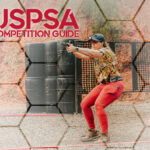

When fall rolls around hunters start to get excited about exploring the woods to hunt for game. For many, that excitement is about big game hunting, they can envision deer coming to their stands, or the sound of an Elk bugling back to their calls. However, there is a small percentage of hunters, like myself, who start dreaming of pheasant hunting.
Don’t get your feathers ruffled, I like to hunt deer as much as the next guy. But there is something that is so damn exciting about hearing a rooster explode from the tall grass and fly off into the sunset. This is called the flush. It is something I have experienced countless times, and I still get as excited today as if it was the first time I experienced it.
Many hunters turn their back to pheasant hunting because they don’t have a gun dog or the knowledge to get started. It’s also possible they’ve stayed away because of the stigma that hunting pheasant is a rich man’s sport.
Pheasant hunting doesn’t need to be complicated, or overly expensive, and certainly can be done without a dog. This pheasant hunting guide will give you a decent outline of how to get started this fall. It’s up to you to get into the woods and hone your craft. Nothing beats time on the ground to gain experience. Hopefully, I’ll see you out there in the field.
Pheasant Hunting 101
Pheasants are known by many as “Chinese Chickens” because they hail from China. They were brought to the States in the late 1800s as game birds. They adapted well to the Midwest and you can now find native pheasants there. Native pheasants are not raised and are considered wild. Native pheasants have healthy(ish) populations in Wyoming, Montana, Utah, Nebraska, and Iowa, but the Dakotas are the Mecca of great pheasant hunting.
Of course, you can find wild birds in other areas as well. For example, in the early 2000s, I used to see native pheasants in a field about 30 minutes north of Boston, Massachusetts. However, like every other amazing game species, development and strip malls are killing off our wild game and hunting grounds.
To combat the lack of native pheasants, some states stock pheasants for hunting. These birds are raised on a farm and released into huntable fields throughout the season. Although hunting these birds is fun, it is a distant second to hunting natives. That being said, a good chunk of the states which allow bird hunting will only have access to stocked pheasants. So, I will try to share information that pertains to both natives and stocks.
What Do Pheasants Eat?
Pheasants are considered omnivores. They will eat plants, berries, corn, insects, worms, spiders, and snails. Basically, pheasants are no different than any other bird. Their diet largely consists of items found in their natural environment.
Natural Habitat
Pheasants live in a variety of territories, but as a whole, they prefer fields with tall grass, wetlands, and farmland. Many pheasant stock sites are cornfields that farmers have allowed the state to release birds on or state-owned land that is usually wet.
Tactics
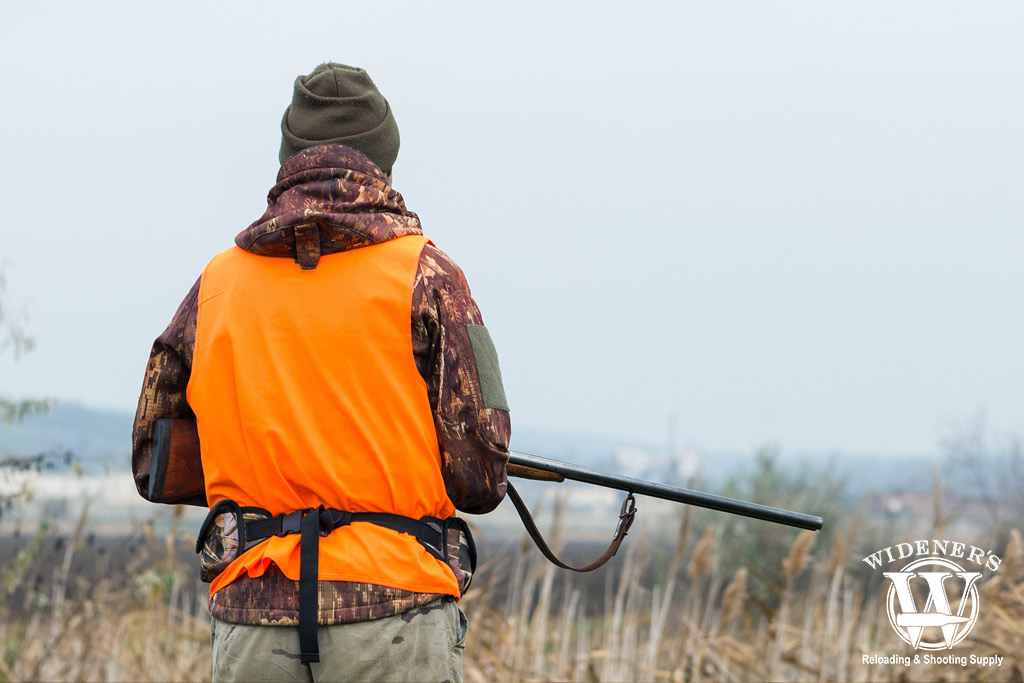
Don’t worry too much about your gear. Pheasant hunting is more about technique, however, be sure to wear a lot of safety-orange!
When talking about pheasant hunting, or really any type of upland bird hunting, there are two main tactics, with or without a dog. Regardless of which tactic you use, you will be walking quite a bit.
Hunting Without A Dog
I am not going to feed you a bunch of B.S., hunting upland birds without a dog is much more difficult than hunting with a dog. I know that is common sense, but I wanted to put it out there. You are now doing all the work of a dog, but you still need to be ready to get a shot. So, how do you do this?
Try to get out in the woods as early as possible and see if you can hear pheasants making calls. You can also get a pheasant call and try calling. However, unlike turkeys, pheasants will not come running to the sound of your call. The call will merely give you a general direction in which pheasants are lingering.
If you established a good area. Start to walk a staggered path towards that area. But, make sure you stop often, because if you don’t, any pheasant near you will keep running away from you and you will never see it. Pheasants don’t like flying, because they are vulnerable, so they run, and boy do they run fast. It is amazing when you see a pheasant and then a few seconds later that same bird is 100 yards away. However, if you are walking behind a bird and stop, the bird will get nervous and flush.
Locations
Try to concentrate your efforts in spots where pheasants are likely to hang out, such as tall grass, crop fields, cornfields, cattails, thick brush, and areas with briars. These areas offer food and protection to the pheasant. After a season or two, you will start to notice “birdy” areas can concentrate on those zones.
You will also see pheasants hanging out near dirt roads, railroad tracks, and paths, filling their crops with grit. If the sun is out these areas can provide you with great success.
If you are hunting dogless, try to not be friendless. The more boots on the ground pushing an area, the more likely you are to see a bird flush. Before I had a dog I would take my wife out with me and have her walk around with me. This doubled my area.
Hunting With A Dog
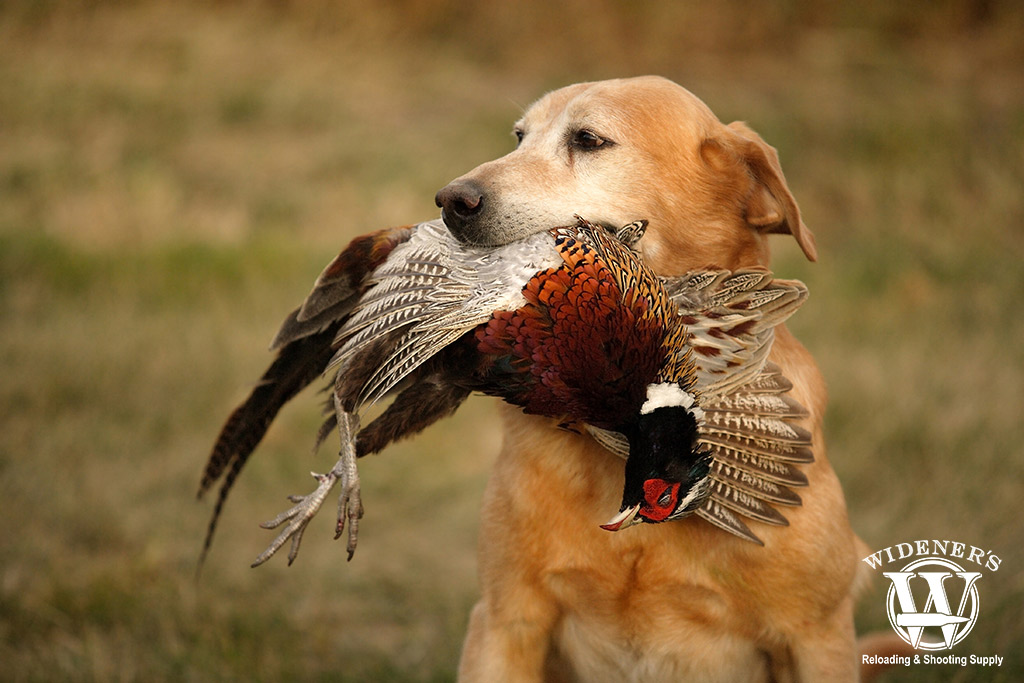
Pheasant hunting with a dog makes things easier, assuming of course that your dog is a well-trained flusher or pointer.
Hunting pheasants with a dog, and by dog, I mean a well-trained bird dog, is one of the simple joys in life. When you have a good dog you simply walk behind them and watch them work.
There are really two types of dogs to consider, flushers and pointers.
Flushers will work some sort of pattern, usually close to the hunter. The dog will get “birdy” as they get closer to a bird. Now, “birdy” is different for all dogs. Some dogs pick up speed, some dogs will vigorously wag their tails, some dogs will start to get closer to the ground like they are ready to pounce. There is no way for me to describe all the “birdy” features. But, a good handler will know when their dog is birdy. When your dog gets birdy, get ready to take a shot, because the flush will happen at any moment.
Pointers will also work some sort of pattern as well, but they will usually range out a little further than flushers. But, pointers get away with it, because they shouldn’t flush the bird till the hunter gives a command, or the hunter flushes it.
Both flushers and pointers have their pros and cons and it really comes down to the owner’s preference.
Dog Breeds
My buddy likes to hunt labs, which flush pheasants. He believes flushers are better because pheasants run, so he wants a dog that will chase and flush the bird. Additionally, he is an avid duck hunter, so labs are a good versatile choice for him. Sound logic to me.
I like pointers and own a German Shorthair. In addition to pheasants, I am an avid grouse and woodcock hunter. I think pointers do a better job on these birds, so I went with a pointer.
At the end of the season, both of us usually limit out, so both dogs are doing something right. As I said, the choice between the flushers and pointers comes down to the hunter and family’s choice.
Common Pheasant Hunting Questions
You will come across birds that refuse to flush, especially planted birds who seem content to nest and watch the world go by. If you’re hunting with dogs, it’s common for them to pick these birds up off the ground and give them a good wringing. It’s not the most exciting way to bag a Pheasant, but your bird dog will be just as excited to present it to you. If it happens to you on the hunt, you own that bird. Be responsible, pick it up, and count it towards your bag limit.
I generally do not recommend shooting birds on the ground in tall grass for safety reasons. Why? It’s hard to see in tall grass, if you can’t see your target and what’s beyond it, it’s not safe to take a shot. You could hit a rock and end up with a pellet ricochet to the face, or unintentionally shoot a dog that wandered too close to the target. If you’re hunting without dogs and see a grounded bird that won’t flush in a clearing, it’s your call on taking the shot. My personal preference is to engage in the sport of taking birds in flight.
What distance is required to flush a bird from its nest? If I’m hunting earlier in the season, I’ll get closer to the birds to flush them than I will later in the season. Why? The birds are motivated to move by how pressured they feel by a predator. As the season goes on, the birds begin to wise up to these distances. It’s not uncommon early in the season to flush birds from distances of 5 yards. However, as the season progresses, you’ll find that some birds make an escape from as far as 20 yards if they get spooked.
Hunting Gear
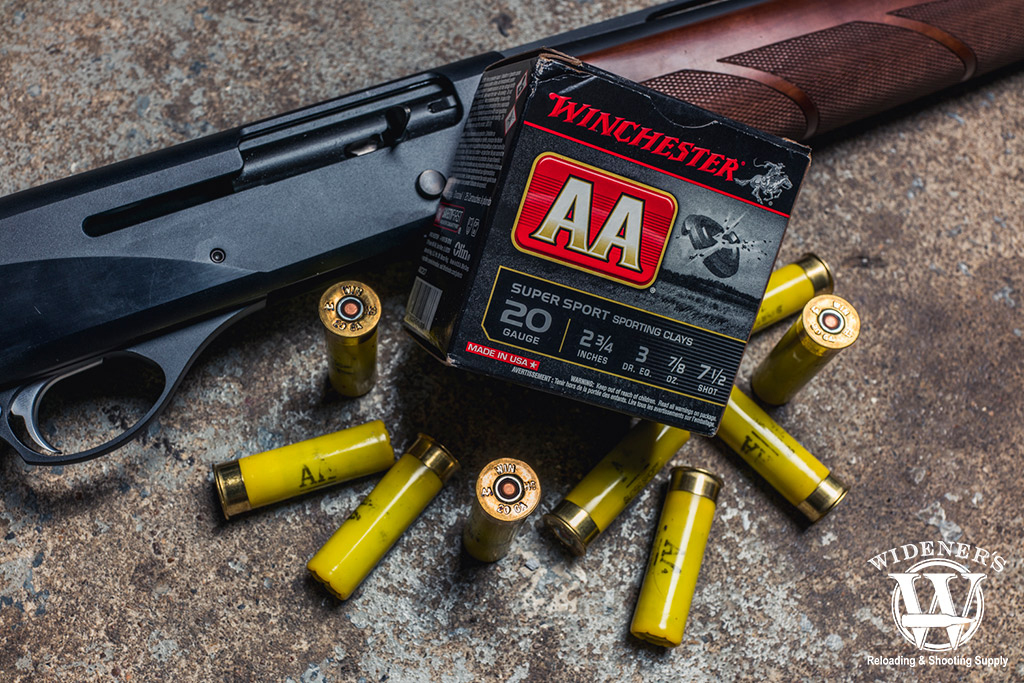
The most popular pheasant hunting shotshells are 4-6 shot lead, however, most companies also make lead-free shells for hunting.
The gear you use for pheasant hunting will be dramatically different than the gear you use for big game or waterfowl.
First off, you will want lots, and I mean lots of orange on. When I first got into pheasant hunting, I wore the bare minimum by State law, which I believe was 300 cubic inches, which is basically a hat and vest. But, then I got shot at a few times by reckless “bird hunters” who claimed not to have seen me. So, now I wear a bright orange shirt or jacket, in conjunction with my hat and vest.
Speaking of vests, make sure you get a good one. One that can hold a couple of birds, some shells, and essential gear like a good knife, sheers, first aid kit, water, snacks, and if you have a dog any gear you may need to carry for them.
I also wear briar-proof pants and gloves. I used to wear heavy-duty jeans, but I would have to buy new jeans halfway through the season, thanks to rips and tears. Not to mention my legs would be covered in cuts and scratches that would itch like crazy. Same with my hands. I never used to wear gloves, but every weekend I would come home and my hands would be bloody and raw. I finally invested in upland bird gloves.
Footwear
Boots are another area in which I ended up investing a lot of money into. For years, I wore a pair of Muck knee-high neoprene waterproof boots. Which are great when walking through marshes and wetlands, but I found them to be uncomfortable and bulky for all-day hikes. So, I ended up buying a pair of hunting boots that are more similar to hiking boots than anything else. They even come with this system called BOA, which gets rid of laces and allows you to tighten your boots with a dial.
Dog Gear
If you get to the point where you are buying a gun dog, you are probably getting serious about bird hunting and this is when you will start to see why upland hunters have this “rich man” stigma. There is some gear I believe is needed when running a gundog. These are e-collars, a briar protection vest, kennels, and a K9 first aid kit. Plus, there are all sorts of little things you may need, such as long leads, bumpers, quality dog food for hunting season, and miscellaneous training items. If you get a gundog researching gear is needed.
Shotgun Recommendations
Unless you end up buying a gundog then a shotgun will be the most costly investment you have bird hunting. Now, that’s not to say you can’t use your grandfather’s old pump, but it will be heavy and uncomfortable for an entire day in the field. When you get serious about pheasant hunting you will want a gun that is light enough to carry all day long and comfortable enough to take numerous shots per trip.
Many old-school hunters will swear by the 16 gauge. It is the perfect combination of accuracy and power. The trouble is many manufacturers have all but abandoned making 16 gauge guns and producing ammo. This leaves you with two realistic choices, the 12 Gauge, and the 20 gauge.
I have used both with great success and it really comes down to preference. With a 20GA you will lose some range out in the field. But, if you are hunting in thick brush with low visibility, 20 gauge shells are ideal. Plus, carrying around a loaded 20GA for a day hunt won’t wear your shoulder out as quickly.
Popular gun choices are over unders, side by sides, and semi-autos. All three have their pros and cons. Personally, I like using my double barrel shotguns for bird hunting. This way I can control my chokes. For example, if I am hunting thick cover I will use a cylinder choke for my first shot and an improved for my second. The cylinder spreads out, so it’s good for close distance “point shooting”, while the improved allows me to keep a tighter pattern for a little more distance.
Pheasant Hunting Ammunition
Realistically, ammunition will be more important than the gauge of your shotgun. The most popular rounds are 4-6 shot lead. However, many companies now make non-toxic pheasant loads.
I try to only use non-toxic shots for two reasons. First, I feed these birds to my family and I have young kids, so I try to avoid lead. Secondly, many of the areas in which I pheasant hunt are surrounded by wetlands and flooded cornfields, which means duck and geese are abundant. I will not pass up the chance to jump shoot a duck or goose, while pheasant hunting.
My choices for ammo are Federal Premium Prairie Storm in #3 shot and Hevi-Metal in #3 shot.
Occasionally, I will use lead and my choices are Federal Premium Upland Load #5 Shot and Remington Premier Shotshells #4-6 shot.
How To Practice
Prior to the season, you will want to practice shooting clays. Pheasants are fast, explosive birds, so you want to make sure you can hit them. This will also give you a chance to see how far your shotgun ranges out and how accurate you are from a distance.
Fitness Considerations
Pheasant hunting can be labor-intensive. You don’t want to spend all summer sitting on your ass drinking beers then expect to limit out in the fields come fall. Try to stay in shape by doing some form of physical activity year-round.
I try to take my dog for walks daily and long walks in the woods on the weekends, this keeps us both in shape. Come August I will start hiking with a backpack with a little bit of weight in it. This just gets my back and shoulders conditioned to the rigors of the hunting pack
Field To Table
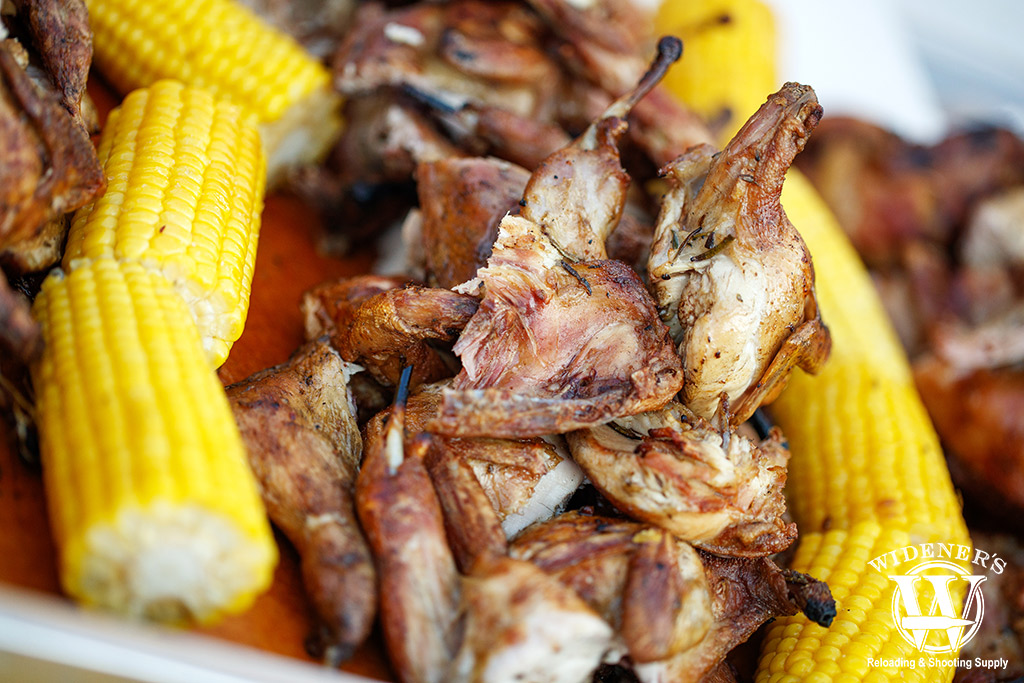
You can find a ton of pheasant recipes online. It’s a tasty game bird that pairs well with a variety of sides and fixings.
Pheasants are delicious. In the past, I would only breast out all my pheasants by stepping on their wings and pulling the legs up. This will separate the breast from the guts and entrails. But, you didn’t get the legs or skin. So now I take my time and pluck all my birds.
I either smoke or braise my pheasants. They can be a little tough, so I found these two methods tenderized them the best.
Give pheasant hunting a try. I bet as soon as you experience a flush, you will be hooked. It takes some time to get decent at it, but as soon as you can start to notice birdy areas and invest in a dog you will spend more time hiking fields than sitting in your stand. Trust me.


